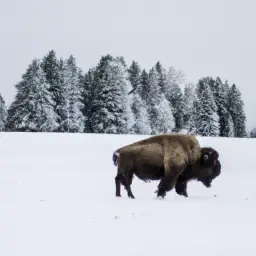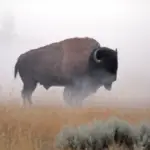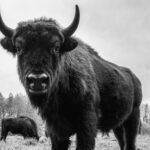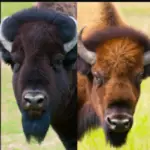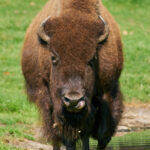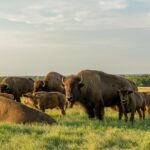Bison’s Physical Adaptations for Cold
Thick Coat of Bison
Bison have evolved a thick and insulating coat to help them withstand the harsh cold temperatures of winter. Their dense fur is composed of two layers: a coarse outer layer and a soft undercoat. This insulation keeps them warm by trapping and retaining air close to their bodies. The outer layer provides protection against the elements, while the undercoat acts as an effective insulator against the cold.
Body Fat & Muscle Mass
In preparation for winter, bison accumulate a significant amount of body fat and increase their muscle mass. This extra fat acts as an energy reserve, providing them with the necessary fuel to endure the frigid temperatures and scarcity of food during the winter months. Bison are known for their incredible ability to convert low-quality forage into fat reserves, enabling them to survive on limited resources and sustaining themselves during the challenging winter conditions.
Physiological Responses
Bison have also developed remarkable physiological adaptations to cope with the cold. They possess a lower surface area-to-volume ratio, which minimizes heat loss. Additionally, their extremities, such as ears, muzzle, and legs, have a reduced blood flow during extreme cold, limiting heat loss and conserving energy. Moreover, bison exhibit a phenomenon called “countercurrent heat exchange” within their circulatory system. This process involves warm arterial blood traveling through large vessels alongside chilled venous blood, allowing the warm blood to heat up the cold blood before reaching the extremities, thus preventing excessive heat loss.
Diet and Nutrition for Winter Survival
Bison’s Winter Diet
During winter, the availability of forage becomes significantly limited, posing challenges for the bison’s diet. However, bison have adapted to survive on a range of plant materials. Their diet primarily consists of dry grasses, sedges, and woody vegetation, such as shrubs and tree bark. Bison are able to utilize their strong jaws and grind down tough vegetable matter, extracting the necessary nutrients despite the seemingly inedible nature of these plants.
Nutrition Consumption during Winter
To meet their nutritional needs during the winter months, bison exhibit behavioral adaptations. They often dig through snow to uncover vegetation, relying on their powerful heads and muscular necks to clear the way. This behavior, known as “microbrowsing,” enables bison to access buried forage and ensures an adequate intake of essential nutrients. By altering their feeding strategies and exhibiting adaptability in their dietary choices, bison are able to sustain themselves through the harsh winter conditions.
The Role of Herd Behavior in Survival
Herd Movement during Winter
One of the key strategies employed by bison to survive the winter is their collective behavior. Bison form large herds during this season, allowing them to effectively navigate the challenging winter landscape. They move together in search of food, often covering extensive distances to find areas where the snow cover is less severe and forage is more accessible. By traveling in groups, bison are able to share knowledge about optimal foraging locations and conserve energy through the tracks created by their fellow herd members.
Social Interactions in the Herd
Social interactions within the herd play a crucial role in the survival of bison during winter. By maintaining close proximity to one another, bison can benefit from the warmth generated by the body heat of their fellow herd members. This close-knit arrangement helps them combat the freezing temperatures, as well as protect each other from predators. Additionally, herd members engage in grooming behaviors, which not only strengthen social bonds but also aid in the removal of snow and ice from each other’s fur.
Young and Elderly Protection
The herd’s collective behavior extends to the protection of vulnerable individuals, such as the young calves and elderly members. Bison mothers form strong bonds with their calves, ensuring their safety and well-being throughout the winter. The herd adopts a defensive formation, with the adults encircling the young and weak, shielding them from the biting winds and potential threats. This collaborative approach enhances the chances of survival for the entire herd, as the vulnerable individuals receive the necessary protection and warmth within the safety of the group.
Hibernation Versus Active Survival
Do Bison Hibernate?
Unlike some hibernating animals, bison do not enter a true state of hibernation during winter. While they do experience physiological adaptations to conserve energy and withstand harsh conditions, they remain active throughout the season. Bison maintain their mobility, continuing to forage for food and navigate their surroundings. This active lifestyle sets them apart from hibernators, allowing them to respond to changing environmental conditions and adapt their behavior accordingly.
Bison’s Active Lifestyle during Winter
Despite the challenging conditions, bison remain active during winter to ensure their survival. They face the constant task of finding suitable forage, exerting energy to dig through the snow and uncover buried vegetation. Their powerful muscles and endurance enable them to move through deep snow, while their resilient nature motivates them to persist in their search for sustenance. By actively engaging with their environment, bison maintain their ability to thrive in the face of winter’s difficulties.
Challenges to Bison Survival in Extreme Cold
Predators in Winter
Surviving extreme cold is not the only challenge faced by bison during winter. Predators, such as wolves and coyotes, take advantage of weakened prey and the scarcity of food resources. Bison must stay vigilant and adopt defensive strategies to protect themselves and their vulnerable herd members. By remaining in large herds, bison increase their chances of detecting predators early and effectively defending against attacks. Their size, strength, and coordinated behavior serve as a formidable defense against potential threats.
Lack of Food Resources
Winter brings with it a scarcity of food resources, presenting a significant challenge for bison survival. The deep snow cover prohibits access to available forage, forcing bison to expend more energy in search of suitable vegetation. In times of extreme cold and limited food, bison rely on their fat reserves accumulated during the summer and fall months. However, if the winter persists for an extended period, and food scarcity becomes severe, bison may face the risk of malnourishment and weakened immunity.
Health concerns in cold
The extreme cold temperatures pose health concerns for bison in winter. Frostbite and hypothermia become potential risks when exposed to prolonged periods of freezing temperatures. However, the bison’s physical adaptations aid in minimizing these risks to some extent. Additionally, the close-knit social structure of the herd helps in detecting and responding to individuals displaying signs of distress or illness. The collective behavior ensures that weakened or sick members receive support and assistance from the rest of the herd, increasing their chances of survival and recovery.
Bison’s Shelter During Cold
Natural Shelter Seeking
In their quest for shelter during the cold winter months, bison instinctively seek out areas that provide natural protection from the elements. They utilize windbreaks, such as tree lines, hills, or valleys, to shield themselves from the biting winds and reduce heat loss. These natural features create microclimates that offer relatively warmer and more stable conditions, allowing bison to find respite from the harsh winter environment. Seeking out these natural shelters helps them conserve energy and survive the cold.
Influence of Wind and snowfall
The force of the wind and the amount of snowfall greatly impact the avail-ability and effectiveness of natural shelters for bison. Strong winds can sweep away or reduce the effectiveness of windbreaks, leaving bison exposed to the full force of the cold. Additionally, heavy snowfall can block access to natural shelters and limit the availability of forage, further increasing the challenges faced by bison. The balance between wind speed, snowfall, and the availability of suitable natural shelters plays a crucial role in determining the sheltering options available to bison.
Reproduction and Survival
Bison Breeding Season
Winter is also a time of importance for bison reproduction. The breeding season, or rut, typically occurs during late summer and early fall. Female bison, known as cows, experience a gestation period of approximately nine months. This results in calves being born during the spring, enabling them to benefit from the better forage availability and warmer temperatures that come with the season. By aligning their reproductive cycles with the seasons, bison maximize the chances of survival for their offspring during winter.
Survival of Bison Calves in winter
Bison calves face unique challenges during winter as they adapt to the harsh conditions shortly after birth. However, their chances of survival are significantly increased due to various factors. The tight-knit social structure of the herd ensures that calves receive protection and warmth from their mothers and the rest of the herd. The collective behavior and knowledge of the older individuals aid in guiding the calves to suitable foraging areas and provide them with opportunities to learn essential survival skills. The resiliency and adaptability of bison calves contribute to their successful survival in winter.
Impact of Climate Change on Bison Survival
Temperature increase effects
Climate change and the resulting temperature increases have significant implications for bison survival during winter. Warmer temperatures can lead to altered precipitation patterns, affecting the availability of forage for bison. The reduced duration and intensity of cold weather may disrupt the synchronization of bison’s physiological adaptations, impacting their ability to cope with the colder periods. Moreover, the changing climate can result in the encroachment of non-native plant species, altering the composition of bison’s winter diet and potentially compromising their nutritional needs.
Increased snowfall
Climate change can also influence snowfall patterns, which have critical consequences for bison survival. Changes in snowfall amounts, timing, or duration can affect the accessibility of forage, making it more challenging for bison to find adequate food resources. Deep snow can restrict their movement, confining them to limited areas and increasing the competition for available food. Furthermore, heavy snowfall can lead to higher energy expenditure as bison must exert greater effort to dig through the snow in search of buried vegetation. These changes in snowfall patterns can pose significant threats to bison populations and their ability to survive winter.
Human Intervention for Bison Survival in Winter
Regular feeding by humans
In certain situations, humans intervene to aid bison in surviving the harsh winter conditions. Wildlife conservationists and park officials may provide supplementary feeding to bison populations when natural food resources are scarce. This practice ensures that the bison have access to sufficient nutrition during times of scarcity and helps prevent malnourishment and starvation. By providing supplemental food, humans can assist in enhancing the chances of survival for bison during winter.
Provision of Artificial Shelters
When extreme weather conditions or habitat destruction pose imminent threats to bison populations, humans may construct artificial shelters to provide protection from the elements. These shelters are designed to mimic natural windbreaks and can offer a safe refuge for bison during frigid temperatures and storms. Although artificial shelters are not a long-term solution, they can provide temporary relief and aid in the survival of bison populations until more sustainable measures can be implemented.
Can Bison Jump Over Obstacles in Extreme Cold Weather?
Bison are remarkable creatures known for their resilience in extreme weather conditions. However, when it comes to the question of whether bison can jump over obstacles in extremely cold weather, there is a need to consider how bison jumping abilities vary. While bison are known for their strength and agility, their ability to jump may be limited in frigid temperatures. The cold weather can affect their muscles, making it more challenging for them to perform high jumps over obstacles.
Conservation Measures for Bison in Winter
Protected Areas
The establishment of protected areas plays a vital role in bison conservation during winter. These areas provide safe havens where bison populations can thrive and find suitable resources. Protected areas often encompass diverse habitats, ensuring the availability of forage and shelter options for bison throughout the winter season. By safeguarding these areas, conservation efforts help preserve the natural ecosystems and ensure the long-term survival of bison populations.
Captive breeding
Captive breeding programs have been instrumental in the conservation of bison populations, including during winter. These programs aim to maintain genetically diverse and healthy populations within controlled environments. By carefully managing breeding and ensuring the health and well-being of captive bison, these programs can serve as a safety net for the species. In the event of severe winter conditions or the decline of wild populations, the captive-bred bison can be reintroduced into their natural habitats, contributing to the overall conservation and survival of the species.

